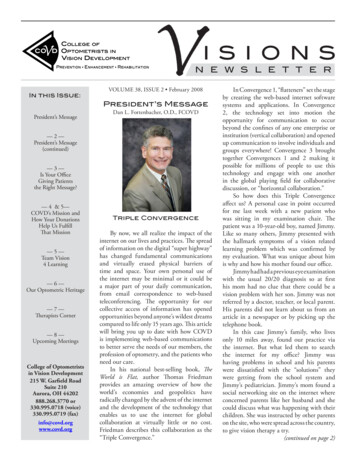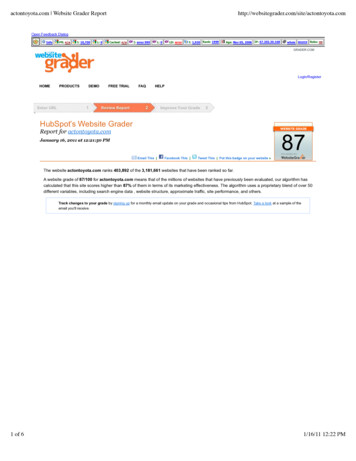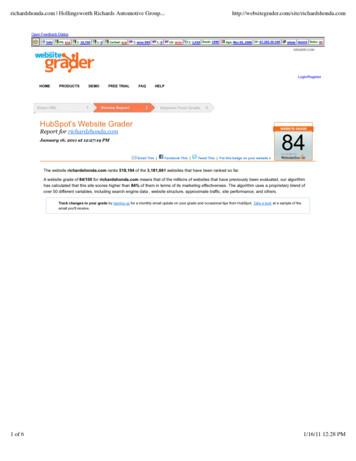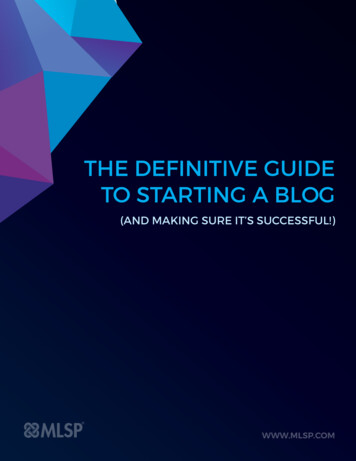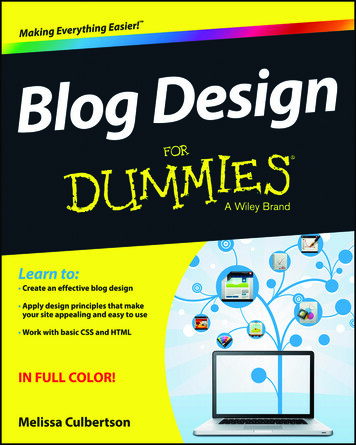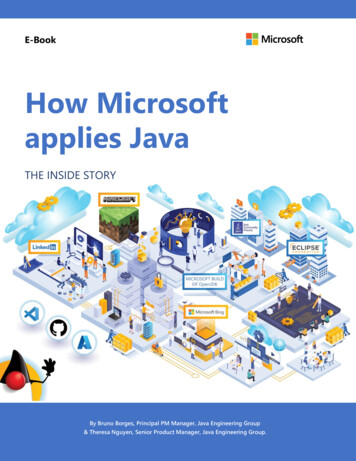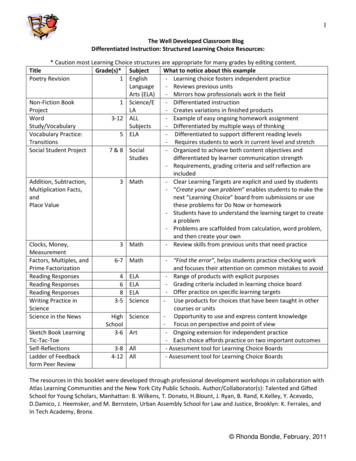
Transcription
1The Well Developed Classroom BlogDifferentiated Instruction: Structured Learning Choice Resources:* Caution most Learning Choice structures are appropriate for many grades by editing content.TitleGrade(s)* SubjectWhat to notice about this examplePoetry Revision1 English- Learning choice fosters independent practiceLanguage- Reviews previous unitsArts (ELA)- Mirrors how professionals work in the fieldNon-Fiction Book1 Science/E- Differentiated instructionProjectLA- Creates variations in finished productsWord3-12 ALL- Example of easy ongoing homework assignmentStudy/VocabularySubjects- Differentiated by multiple ways of thinkingVocabulary Practice:5 ELA- Differentiated to support different reading levelsTransitions- Requires students to work in current level and stretchSocial Student Project7 & 8 Social- Organized to achieve both content objectives andStudiesdifferentiated by learner communication strength- Requirements, grading criteria and self reflection areincludedAddition, Subtraction,3 Math- Clear Learning Targets are explicit and used by studentsMultiplication Facts,- “Create your own problem” enables students to make theandnext “Learning Choice” board from submissions or usePlace Valuethese problems for Do Now or homework- Students have to understand the learning target to createa problem- Problems are scaffolded from calculation, word problem,and then create your ownClocks, Money,3 Math- Review skills from previous units that need practiceMeasurementFactors, Multiples, and6-7 Math- “Find the error”, helps students practice checking workPrime Factorizationand focuses their attention on common mistakes to avoidReading Responses4 ELA- Range of products with explicit purposes- Grading criteria included in learning choice boardReading Responses6 ELA- Offer practice on specific learning targetsReading Responses8 ELAWriting Practice in3-5 Science- Use products for choices that have been taught in otherSciencecourses or units- Opportunity to use and express content knowledgeScience in the NewsHigh Science- Focus on perspective and point of viewSchoolSketch Book Learning3-6 Art- Ongoing extension for independent practiceTic-Tac-Toe- Each choice affords practice on two important outcomesSelf-Reflections3-8 All- Assessment tool for Learning Choice BoardsLadder of Feedback4-12 All- Assessment tool for Learning Choice Boardsform Peer ReviewThe resources in this booklet were developed through professional development workshops in collaboration withAtlas Learning Communities and the New York City Public Schools. Author/Collaborator(s): Talented and GiftedSchool for Young Scholars, Manhattan: B. Wilkens, T. Donato, H.Blount, J. Ryan, B. Rand, K.Kelley, Y. Acevado,D.Damico, J. Heemsker, and M. Bernstein, Urban Assembly School for Law and Justice, Brooklyn: K. Ferrales, andIn Tech Academy, Bronx. Rhonda Bondie, February, 2011
2Poetry Revision Choice BoardBen Wilkens, First Grade, Talented and Gifted Young Scholars (M012)Purpose: To foster purpose individual revision of poetry.Directions to Teachers: Use this Learning Choice Editing as a center or as an assignment.Supports and Extensions: Teachers assign students ways for students to revise their poems. Student can reflect on their writingover time and notice patterns in figurative language and writing techniques that they use often. Students can then select a revisethat will both strengthen the piece of writing as well as their portfolio.Sample Common Core Standards Addressed:Reading K-5Responding to Literature – Grade 111. Recognize and make connections in narratives, poetry, and drama to other texts, ideas, cultural perspectives, personal events, and situations.a. Self-select text based upon personal preferences.Responding to Literature – Grade 411. Create and present a poem, dramatization, art work, or personal response to a particular author or theme studied in class, with support as needed.Language Standards K-5Conventions of Standard English – Grade 12. Demonstrate command of the conventions of standard English capitalization, punctuation, and spelling when writing.a. Capitalize dates and names of people.b. Use end punctuation for sentences.c. Use commas in dates and to separate single words in a series.d. Use conventional spelling for words with common spelling patterns and for frequently occurring irregular words.Spell untaught words phonetically, drawing on phonemic awareness and spelling conventions.5. Conventions of Standard English – Grade 46. Demonstrate understanding of figurative language, word relationships, and nuances in word meanings.a. Explain the meaning of simple similes and metaphors (e.g., as pretty as a picture) in context.b. Recognize and explain the meaning of common idioms, adages, and proverbs.c.Demonstrate understanding of words by relating them to their opposites (antonyms) and to words with similar but not identical meanings (synonyms). Rhonda Bondie, February, 2011
3Poetry Revision Learning Choice BoardChoose at least two ways to revise your poem.Your revisions will help your poem communicateits message more effectively.AlliterationSimileAnother StanzaAdd alliteration to your poem.Hear the same letter or sound at thebeginning of words close together.Add a simile to your poem.Compare one thing to another withthe phrase “ like a or“as as a ”.Example: as quick as a wink orhot like the sunAdd another stanza to your poem.AdjectiveSynonymRhymeAdd an adjective to describe a nounin your poem.Examples: huge, fast, prickly, andshinyReplace a plain word on your poemwith a more interestingand precise synonym.Examples:change “fun” to “amusing”,change “good” to “excellent”or change “big” to “gigantic”.Add a rhyme to your poem.Example:We delight in spring’s colorful sight.Example: Creative Class.
4Non-Fiction Book ProjectOriginal idea Ben Wilkens, 1st Grade, Talented and Gifted Young Scholars (M012)Purpose: To provide a sequenced structure for completing a multi-step project. All students willcomplete the first four squares.Directions to Teacher: Students will be assigned one visual feature and one text feature basedon their ability and students will choose one visual and text feature to add based on theirinterest. Early finishers can add more features to their book. During a sharing exhibitionstudents can tally how often authors used the different features in their book projects.Supports and Extensions:The teacher will assign all students at least one square based on a skill that the student needsto work on. Early finishers can use the chart as an anchor activity to add more features to theirbook.Sample Common Core Standards Addressed:Speaking and Listening Standards – Grade 1Presentation of Knowledge and Ideas4. Describe people, places, things, and events with relevant details, expressing ideas and feelings clearly.5. Add drawings or other visual displays to descriptions when appropriate to clarify ideas, thoughts, and feelings.6. Produce complete sentences when appropriate to task and situation. (See grade 1 Language standards 1and 3 onpage 26 for specific expectations.)Range of Writing – Grade 110. Write routinely over extended time frames (time for research, reflection, and revision) and shorter timeframes (a single sitting or a day or two) for a range of discipline-specific tasks, purposes, and audiences.Research to Build and Present Knowledge – Grade 17. Participate in shared research and writing projects (e.g., explore a number of “how-to” books on a given topic anduse them to write a sequence of instructions).8. With guidance and support from adults, recall information from experiences or gather information from providedsources to answer a question.Research to Build and Present Knowledge – Grade 47. Conduct short research projects that build knowledge through investigation of different aspects of a topic.8. Recall relevant information from experiences or gather relevant information from print and digital sources; takenotes and categorize information, and provide a list of sources.
5Non-Fiction Book ProjectE3IndexDiagram orConcept MapDBold Vocabulary WordsC2GlossaryData TableBHeadingsA1Picture with CaptionTextFeaturesTable of ContentsCorrect grammarand spelling.See teacher beforemoving forward.Memorable EndingShow how thebeginning and middlefit together to create abetter understanding ofthe topic.Detailed MiddleProvide the reader withat least three importantideas about the topicand supports thoseideas with facts.Engaging BeginningIntroduce the topic andexplains why it isimportant.VisualFeatures
6Non-Fiction Book ProjectOriginal idea Randi Toll, 1st Grade, P.S. 163Purpose: To provide a structure for completing centers in a science unit on butterflies. Allstudents will complete the starred activities first. These provide ongoing assessment data for theteacher.
7Butterfly Choice BoardInstructions: Complete as many activities as you can! You must complete thestarred activities first *Group of ThreePartnerScientific observationsof caterpillars andbutterfliesButterfly mathButterfly Symmetry*Time for Kids*IndependentWrite your ownaddition or subtraction wordproblem aboutbutterfliesHave a debate withComplete theyour partner. One of Life Cycle Puzzleyou believes butterfliesare the best pet andthe other believes thatdogs are the best pet.*Read the HungryWrite a poem about aGenerate questionsCaterpillar by Eric Carle butterfly, caterpillar, orabout the photographs and make a list of things the life cycleof butterflies in their in the book that arehabitatfiction and things thatare nonfiction
8Word Study/Vocabulary Learning ChoicesPurpose: To invite learners to practice problem solving with language. Through this Learning Choice boardstudents are challenged to look for explore multiple meanings of words through different ways of thinking anduse multiple communication methods to express ideas.Directions:Use this learning Choice board as an ongoing homework assignment.Management Tip: Number the squares or choices to facilitate grouping students.Supports and Extensions: All students can use this learning choice board with different sets of assigned words. The teacher can assign students one choice (using the numbers) to ensure appropriate challenge for eachstudent. Then students can be group by similar numbers to learn more about different words using afamiliar assignment or could be grouped so that each student completes a different task with the sameword. Grouping: The students can complete all tasks and then group themselves by the number of the task thatwas most useful to them in learning their words. Knowing the kinds of tasks that helps students learn canthen be used to when studying for tests and completing other assignments.Sample Common Core Standards Addressed:Language Standards K-5Vocabulary Acquisition and Use – Grade 35. Demonstrate understanding of word relationships and nuances in word meanings.a. Distinguish the literal and nonliteral meanings of words and phrases in context (e.g., take steps).b. Identify real-life connections between words and their use (e.g., describe people who are friendly or helpful).Distinguish shades of meaning among related words that describe states of mind or degrees of certainty (e.g., knew, believed,suspected, heard, wondered).Vocabulary Acquisition and Use – Grade 64. Determine or clarify the meaning of unknown and multiple-meaning words and phrases based on grade 6 reading andcontent, choosing flexibly from a range of strategies.a. Use context (e.g., the overall meaning of a sentence or paragraph; a word’s position or function in a sentence) as a clueto the meaning of a word or phrase.b. Use common, grade-appropriate Greek or Latin affixes and roots as clues to the meaning of a word (e.g., audience,auditory, audible).c. Consult reference materials (e.g., dictionaries, glossaries, thesauruses), both print and digital, to find the pronunciationof a word or determine or clarify its precise meaning or its part of speech.d. Verify the preliminary determination of the meaning of a word or phrase (e.g., by checking the inferred meaning incontext or in a dictionary).5. Demonstrate understanding of figurative language, word relationships, and nuances in word meanings.a.b.c.Interpret figures of speech (e.g., personification) in context.Use the relationship between particular words (e.g., cause/effect, part/whole, item/category) to better understand eachof the words.Distinguish among the connotations (associations) of words with similar denotations (definitions) (e.g., stingy, scrimping,economical, unwasteful, thrifty).6. Acquire and use accurately grade-appropriate general academic and domain-specific words and phrases; gather vocabularyknowledge when considering a word or phrase important to comprehension or expression.
9Word Study/Vocabulary Learning ChoicesNameWords that I am studyingComplete two tic-tac-toes to learn your words.1. If your words were colorsthen what colors would theybe and why?2. Compare your each of yourwords to another word usingthis format.(your word) is likebecause . Repeatthis pattern for each word.3. Find your words in atextbook. Make a list of yourword, the page # where it canbe found and copy thesentence where the word isused. If you can’t find the wordin your textbook then try otherbooks, newspapers,magazines, and the Internet.4. Draw an image or symbolthat represents your word.5. Write the definitions of eachof your words.6. Write a question that theanswer would be one of yourwords. Create a question foreach of your words.7. Explain why this word isimportant to know. Offerexamples of how people canuse the word.8. Find an image that9. Create a group of five wordsrepresents each of your words. that one of your words wouldfit into. Give the group a title.Create a group of words with atitle for each of your words.
10Word Bank for Transition Words Found In Independent Reading Used in WritingJackie Heemsker, 5th Grade, Talented and Gifted Young Scholars (M012)Purpose: To guide note taking during independent reading and revisions during writing.Directions for Supports and Extensions:The words have been divided into three categories, related to words often found in texts of different readinglevels. Students are assigned to notice transition words during their independent reading. Once students havebegun to notice transition words then they can share with a partner or in a small group the word quoted from asentence or paragraph in their book and how the transition strengthened the author’s message.Notice: Groups are expected to find words from two columns. This instructional strategy is intended to offer everystudent both a familiar task and a challenge. If the teacher only gave the words in the middle column thenstudents reading on a lower reading level (English Language Learners and/or struggling readers) might not besuccessful in finding the words. At the same time, the third column ensures that students reading advanced bookswill be able to look for challenging vocabulary. By using three columns in the word bank, the teacher is providingboth supports and extensions within one assignment.Sample Common Core Standards Addressed:Language Standards Grade 56. Acquire and use accurately grade-appropriate general academic and domain-specific words and phrases,including those that signal contrast, addition, and other logical relationships (e.g., however, although,nevertheless, similarly, moreover, in addition).Language Standards 6-123. Use knowledge of language and its conventions when writing, speaking, reading, or listening.a. Vary sentence patterns for meaning, reader/listener interest, and style.*
11Word Bank for Transition Words Found In Independent Reading Used in WritingIn your reading notice how the author uses transitions. Jot down the page number and a sentence where transitionwords are used. In your writing, explore using these words to clarify your message.Group 1 find three words from column, Starting Out, and at least two words from Frequent Use.Group 2 find three words from column, Frequent Use, and two words from Sophisticated.Group 3 find two words from column, Frequent Use, and three words from column Sophisticated. All groups make note of words that you find to add to our list. Notice how often you see the word used in texts.PurposeSignal aSeriesHelpful whendescribing aprocessShow acomparisonShowContrast orChangeIndicate Placeor locationstarting orhereinintooverthereunderfrequent useafter thatanotherbesidesbut alsofinallyin additionin the first houghanyhowanywayeithereven thoughhoweverinsteadneitheron the other etweenbeyondsophisticatedequally erthen tooto concludeafterwardsto start withby comparisonas withas thoughin the like mannerat the same timeby contrastdespitefor all thatin any eventin contrastin spite ofneverthelessnonethelessnornotwithstandingon the osite
12Learning Choice Board Example Social StudiesCollaborators: Tom Donato & Rhonda Bondie, Talented and Gifted School for Young ScholarsPurpose: To offer ongoing small research projects to practice informative and explanatory writing using researchto support ideas.Directions for Implementing Supports and Extensions:Learning Choices are carefully placed on the chart to meet a specific content goal and require students to use aparticular communication method. This enables teachers to support struggling learners by assigning a task in anarea of strength to complete first, such as drawing or speaking and to work in the content area that has the mostinterest. Then the second learning choice could be assigned specifically to stretch students into areas of challenge.Sometimes teachers assign two choices in an area of difficulty to develop skills or knowledge in this area.Additional choices could be selected by students.Content Learning Goals/TargetsPlacesPeopleEventsMethods of CommunicationWritingDrawingSpeakingManagement Tips:- The product size for each learning choice is carefully chosen by the teacher to match the time andresources available for a particular unit.- The grading criteria for high quality work are the same for all products. Only one grading rubric or criteriais used.Common Core Standards Addressed:Writing Standards for Literacy in History/Social Studies, Science, and Technical Subjects 6–12Grades 6–8 students:1. Write arguments focused on discipline-specific content.a. Introduce claim(s) about a topic or issue, acknowledge and distinguish the claim(s) from alternate oropposing claims, and organize the reasons and evidence logically.b. Support claim(s) with logical reasoning and relevant, accurate data and evidence that demonstrate anunderstanding of the topic or text, using credible sources.c. Use words, phrases, and clauses to create cohesion and clarify the relationships among claim(s),counterclaims, reasons, and evidence.d. Establish and maintain a formal style.Provide a concluding statement or section that follows from and supports the argument presented.
13Learning Choice Board Example Social StudiesDetails toinclude:WritingDrawingSpeakingPlaces Physical features Why physical featuresare important How place haschanged Cite referencesPeople Life Work/Legacy How person’sactions haveimpacted theworld today Cite referencesCreate a diary of an explorer orsomeone who lived at this timeperiod that helps the readerunderstand the physicalfeatures of a place.orCreate a poem describingfeatures of a place and why thefeatures are importantCreate two maps that showhow something changes overtime.Write a biography of animportant person.Create a commercial aimed atparents encouraging them tovisit a particular place with theirfamily. Be sure to explain whychildren will be interested in theplace and how visiting the placecan help children learn history.Draw a collection ofobjects that represent aperson. Be sure toinclude a key thatexplains what each objectis and why it is importantto understanding the lifeand accomplishments ofthis person.Create a campaigncommercial encouragingvoters to support acandidate or legislation.High quality work: Completes three assignments for a tic-tac-toe Is historically accurate Supports claims with facts Cites sources Makes novel connections Includes a reflection sheet for each completedassignment Presented well (neat, organized, logical, correctspelling and grammar)Events Known facts, who, what,why, when, where Pivotal moment (criticalpoint during this event thatleads to an importantoutcome) Clear point of view orperspective Cite referencesWrite a letter to a friend describingan event as if you were there. Besure to include enough details sothat the reader can imagine what itwas to be at the event.Construct a timeline comparing achain of events of this time periodto a chain of events happening atanother place during the same timeperiod or a chain of eventshappening at another time period.Be sure to include a shortexplanation drawing our attentionto what this comparison tells us.Prepare a news brief from areporter broadcasting live from anevent.Reflection Sheet (complete one sheet for each task)On a sheet of paper labeled Reflection Sheet, writea response to the following four prompts:1. I choose (list task that you completed).2. I was interested in this topic/task because3. From the experience of completing this task,I learned4. Next time I would like to
14Addition, Subtraction, Multiplication Facts and Place ValueHelene Blount, 3rd Grade, Talented and Gifted Young Scholars (M012)Jamilah Ryan, 6th Grade, Talented and Gifted Young Scholars (M012)Purpose: To provide independent practice and ongoing review/development of computation and problem solving skills.Management Tips:- Ask students to create new learning choice boards using the problems submitted by fellow students as extension projects. Require students to usea table with objectives for each column and objectives for each row, so that each problem must meet the objective for both the vertical and thehorizontal rows. Challenge students to think very critically about each problem that is selected and why it is a good fit for the objectives. Requirestudents to create an answer sheet so that when other students are using their learning choice board will be able to self-correct their work.-Offer the learning choice boards made by students as review assignments to support students who are struggling.-Assign students to do the rows and columns of learning choice boards for extra practice in areas of weakness following a test.-Use errors from student work for “find the error” column. Invite students to check homework in small groups and record common errors on indexcards, and then use the collect problems for learning choice boards.Sample Common Core Standards Addressed:Standards for Mathematical Practice K -121 Make sense of problems and persevere in solving them.4 Model with mathematics.5 Use appropriate tools strategically.6 Attend to precision.
15Addition, Subtraction, Multiplication Facts and Place ValueDirections: Complete three squares in a row to make a Tic-Tac- Toe.ComputationAddition withRegrouping469 187878.69 692.12Subtraction withRegroupingMultiplicationwith Regrouping534- 91,753 5,6381,817.50 1,895.75402-3360- 27748- 5597x917x523x932x 64Word ProblemCreate Your Own ProblemKendra was playing a computer game wherethe players could travel around the world. Thefirst game she traveled 413 miles. The secondgame she traveled 218 miles. The third gameshe traveled 674 miles. How many miles didshe travel over the course of the three games?Create a story problem where at leasttwo numbers are added withregrouping in the solution.Brian wanted a computer for 475.00 and aprinter for 360.00. In order to buy thecomputer, Brian worked for three months. InApril he earned 175.00, in May, 239.00, andin June, 420.00. Did he earn enough moneyto purchase the computer? How much moremoney does he need to earn or how muchchange would he receive back?Create a story problem where at leasttwo numbers are subtracted withregrouping in the solution.Jesse spends 45 minutes everyday practicinghis keyboarding skills. If he practices everydayfor one week then how many minutes did hepractice? How many more minutes would hepractice if he practices everyday for threeweeks?Create a story problem where at leasttwo numbers are multiplied withregrouping in the solution.Write out both your problem and thesolution.Write out both your problem and thesolution.Write out both your problem and thesolution.
16Clocks, Money, Measurement Choice BoardDirections: Complete three squares in a row to make a Tic-Tac-Toe. Your projects should complete the task, be neat,and show your math work. Include a written paragraph that explains your answer.Addition withRegroupingSubtraction withRegroupingMultiplicationwith RegroupingClocksMoneyMeasurementWrite down your daily schedule byhours for one week including items atschool, things you do at home, andother activities. Create a reportshowing the total amounts of time youspend at school, eating, sleeping,studying, playing and going otheractivities.Use a menu of a sale paper to plan what youwould like to buy. Make a wish list of what youwould like to order or buy and the prices. Thetotal must be at least 150.00.Find the perimeter of a book or piece offurniture.Explain to a traveler what time theywould have to leave to arrive at alocation at a specific time. Show themhow long it will take from the start timeto the finish time of their trip.You have 250.00 to spend on a three day trip.Create a budget for each day listing what youwould buy and how much it would cost. List foreach day how much money would be left.Explain how much money would be leftover atthe end of the trip.Measure the objects in your backpack or thefood from a grocery bag or the things on ashelf in your room.Create a workout schedule. Decidehow many times per week and for howlong each time you will exercise.Explain how much total time eachweek you will exercise. Divide yourtargeting different parts of your body.How much time each week are youspending focused on each part?You are opening a sneaker shop. The shelves Find the area of a room or playground.in your store can hold 12 sneakers or 6 pairs ofsneakers. How many different sizes and types Explain why would knowing the area beof sneakers will you display? How manyuseful to someone?shelves will you need to display the pairs ofshoes for customers to try on?Explain: Why would knowing the perimeterbe useful to someone?Find the difference between at least twomeasurements.
17Factors, Multiples and Prime Factorization Choice BoardAnswer# of days ittakes for themoon to make afull revolution(28)# of days in aleap year(366)# of days in aregular week(7)Word ProblemDavis and Luisa both work at Tommy’sPizzeria throughout the week. They earnthe same amount of money per day. IfDavis made 252 and Luisa made 224this week, how much money do theymake per day. Please use primefactorization to show your solution.On Sundays, The A train arrives at the125th Street station every 16 minutes.The D train arrives every 21 minutes.How many minutes will elapse before thetrains arrive at train station at the sametime? It is 12:30 pm now and both trainsare at the station, at what time will thetrains meet again?Djali has 42 Snickers bars and 63 ThreeMusketeers bars. If she wants to makeHalloween grab bags, what is thegreatest amount of grab bags she canmake if she must have exactly the samenumber of Snickers and exactly thesame number of Musketeers in eachbag? Please diagram your solution.Find the ErrorHector is trying to find the primefactorization of 840.He writes the prime factorization of840 as 2*3*5*23.Is Hector’s answer correct or not?Explain what Hector could have done tocheck his work. Show the correction heneeds to make.There is a star with four orbitingplanets. One planet makes a trip aroundthe star in 7 Earth years, the secondplanets takes 6 Earth years, the thirdtakes 16 Earth years, and the fourthtakes 21 Earth years. How many years,will it take for the planets to return tothis position?Deena states that it will take 14,112years. Explain how Deena found heranswer and how she can solve itcorrectly.Neena has 21 smiley-face stickers, 54glittery stickers and 84 heart stickers.Elaine states that Neena can only dividethe stickers evenly among 3 friends.Create a diagram that shows how Elainesolved this problem and explain whethershe is correct or not.Createa) Create a word problem withthis answer that uses eitherdivision or prime factorizationto get to the answer.b) Create a word problem thatuses the answer in the primefactorization.Show the solution to the wordproblem.a) Create a word problem withthis answer that usesmultiplication and/or findingcommon multiples to get tothe answer.Show the solution to the wordproblem.a) Create a word problem withthis answer that uses divisionand/or finding commonfactors to get to the answer.Show the solution to the wordproblem.
18Reading Response Tic-Tac-ToeKatie Kelley, 4th Grade, Yvonne Acevado, 6th Grade, Dru Damico, Talented and Gifted School for Young ScholarsPurpose: To provide explicit goals for reading response assignments and choose an assignment that is purposefulto the reading assignment.Management Tips:- Provide different types of structured paper for different products, such as script paper with two columns,the first column with a line for the character’s name and the second column several lines for what thecharacter says (see below).- Add Supports and Extensions by placing Word Banks or labels such as Beginning, Middle (problem), andEnd to guide students in their product. By placing the supports and extensions on the “special projectpaper” teacher
Synonym Replace a plain word on your poem with a more interesting and precise synonym. Examples: change "fun" to "amusing", change "good" to "excellent" or change "big" to "gigantic". Rhyme Add a rhyme to your poem. Example: We delight in spring's colorful sight. 4 Non-Fiction Book Project .


